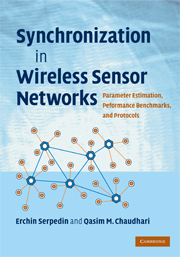 Synchronization in Wireless Sensor Networks
Synchronization in Wireless Sensor Networks Book contents
- Frontmatter
- Contents
- Preface
- 1 INTRODUCTION
- 2 SIGNAL MODELS FOR TIME SYNCHRONIZATION
- 3 TIME SYNCHRONIZATION PROTOCOLS
- 4 FUNDAMENTAL APPROACHES TO TIME SYNCHRONIZATION
- 5 MINIMUM VARIANCE UNBIASED ESTIMATION (MVUE) OF CLOCK OFFSET
- 6 CLOCK OFFSET AND SKEW ESTIMATION
- 7 COMPUTATIONALLY SIMPLIFIED SCHEMES FOR ESTIMATION OF CLOCK OFFSET AND SKEW
- 8 PAIRWISE BROADCAST SYNCHRONIZATION (PBS)
- 9 ENERGY-EFFICIENT ESTIMATION OF CLOCK OFFSET FOR INACTIVE NODES
- 10 SOME IMPROVED AND GENERALIZED ESTIMATION SCHEMES FOR CLOCK SYNCHRONIZATION OF INACTIVE NODES
- 11 ADAPTIVE MULTI-HOP TIME SYNCHRONIZATION (AMTS)
- 12 CLOCK DRIFT ESTIMATION FOR ACHIEVING LONG-TERM SYNCHRONIZATION
- 13 JOINT SYNCHRONIZATION OF CLOCK OFFSET AND SKEW IN A RECEIVER–RECEIVER PROTOCOL
- 14 ROBUST ESTIMATION OF CLOCK OFFSET
- 15 CONCLUSIONS AND FUTURE DIRECTIONS
- Acronyms
- References
- Index
4 - FUNDAMENTAL APPROACHES TO TIME SYNCHRONIZATION
Published online by Cambridge University Press: 05 August 2012
- Frontmatter
- Contents
- Preface
- 1 INTRODUCTION
- 2 SIGNAL MODELS FOR TIME SYNCHRONIZATION
- 3 TIME SYNCHRONIZATION PROTOCOLS
- 4 FUNDAMENTAL APPROACHES TO TIME SYNCHRONIZATION
- 5 MINIMUM VARIANCE UNBIASED ESTIMATION (MVUE) OF CLOCK OFFSET
- 6 CLOCK OFFSET AND SKEW ESTIMATION
- 7 COMPUTATIONALLY SIMPLIFIED SCHEMES FOR ESTIMATION OF CLOCK OFFSET AND SKEW
- 8 PAIRWISE BROADCAST SYNCHRONIZATION (PBS)
- 9 ENERGY-EFFICIENT ESTIMATION OF CLOCK OFFSET FOR INACTIVE NODES
- 10 SOME IMPROVED AND GENERALIZED ESTIMATION SCHEMES FOR CLOCK SYNCHRONIZATION OF INACTIVE NODES
- 11 ADAPTIVE MULTI-HOP TIME SYNCHRONIZATION (AMTS)
- 12 CLOCK DRIFT ESTIMATION FOR ACHIEVING LONG-TERM SYNCHRONIZATION
- 13 JOINT SYNCHRONIZATION OF CLOCK OFFSET AND SKEW IN A RECEIVER–RECEIVER PROTOCOL
- 14 ROBUST ESTIMATION OF CLOCK OFFSET
- 15 CONCLUSIONS AND FUTURE DIRECTIONS
- Acronyms
- References
- Index
Summary
As described in Chapter 3, various protocols targeting clock synchronization in WSNs have been proposed, mainly based on packet synchronization techniques. In general, this family of protocols can be broadly divided into two fundamental approaches: sender–receiver synchronization (SRS), see, e.g., and receiver–receiver synchronization (RRS), see, e.g. SRS relies on the traditional model of two-way message exchanges between a pair of nodes. For RRS, the nodes to be synchronized first receive a beacon packet from a common sender, then compare the receiving times of the beacon packet to compute the relative clock offsets. Most of the existing time synchronization protocols rely on one of these two approaches. For instance, NTP and TPSN adopt SRS since they depend on a series of pairwise synchronizations that assume two-way timing message exchanges. Notice also that the RBS protocol relies on RRS since it requires pairs of message exchanges among children nodes (except the reference) to compensate their relative clock offsets.
A new approach for time synchronization, called receiver-only synchronization (ROS), has also been proposed. The aim of ROS is to minimize the number of required timing messages and energy consumption during synchronization while preserving a high level of accuracy. This approach can be used to achieve network-wide synchronization with many fewer timing messages than other wellknown protocols such as TPSN and RBS.
Next we will present and analyze each of these synchronization approaches and illustrate how the general design considerations can be resolved in these approaches.
Information
- Type
- Chapter
- Information
- Synchronization in Wireless Sensor NetworksParameter Estimation, Performance Benchmarks, and Protocols, pp. 32 - 41Publisher: Cambridge University PressPrint publication year: 2009